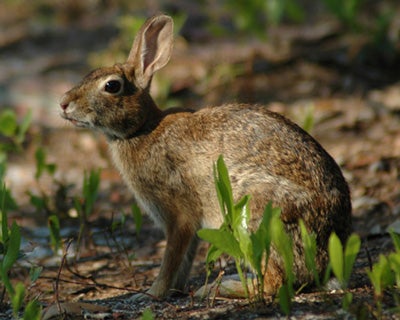SCIENTIFIC NAME:
Sylviagus floridanus
STATUS:
Common and found statewide. Lowest Conservation Concern.
DESCRIPTION:
Cottontail rabbits (Sylvilagus floridanus) have short, fluffy, white tails that are raised when alarmed. The hind legs and feet are much longer than the front legs and feet. In relation to head size, the ears are disproportionately long. The body fur is usually a reddish-brown color with a white under-side. Adult cottontail rabbits normally weigh between two and four pounds and have a body length of 12 to 19 inches.
DISTRIBUTION:
Sylvilagus floridanus is commonly found in the eastern United States and southern Canada. They are also found in fewer numbers in eastern Mexico and Central America. They are Alabama’s most abundant rabbit and found throughout the state.
HABITAT:
The cottontail rabbit is almost entirely vegetarian and is therefore associated with early growth habitats such as fields and fencerows that provide the necessary food and cover. They are very successful in areas that provide a variety of habitat types within their home range. Lands containing mixtures of croplands, pastures, idle fields, and hay fields offer good cottontail habitat. Cut-over forest lands also provide good cottontail areas, as well as plum thickets, briar patches, brush, fencerows, and un-mowed ditch banks.
FEEDING HABITS:
During summer, the majority of a cottontail’s diet consists of grasses, sedges, fruits, buds, sprouts, and other tender green vegetation. Cottontails also like to invade gardens for “dessert foods” like beans and lettuce. Leaves, waste grains, grasses, forbs, bark and stems of young trees and shrubs are important winter foods.
LIFE HISTORY AND ECOLOGY:
In Alabama, cottontails usually breed from February through early fall. Females will create a slight depression in the ground for a nest. This depression is usually in an area of dense grass for protection. Males may mate with several females during this time. Gestation usually takes 28 to 30 days with a litter size of one to eight. Average litter size is three to four. Females are able to produce 20 or more young per year. Young cottontails are about the size of a man’s thumb and are blind when born. Cottontails have a potential life span of about eight to 10 years, but few ever reach that age in the wild. The average life expectancy of a cottontail in the wild is only four to six months.
REFERENCES:
Madson, John, 1963. The Cottontail Rabbit. Olin Mathieson Chemical Corporation, East Alton, Illinois. 56 pp.
Waters, Robert E., 1994. Some Things You Should Know About Wildlife in Alabama. Alabama Forestry Planning Committee. 162 pp.
AUTHOR:
Randy Liles, Wildlife Biologist, Division of Wildlife and Freshwater Fisheries






